Kentucky Pesticide Safety Education Program

Questions?
Contact
Dr. Ric Bessin
Dept. of Entomology
University of Kentucky
859-257-7450
rbessin@email.uky.edu
Wood-Destroying Organisms (WDO)
Several species of fungi and insects normally infest wood, using it for food and/or shelter. Recognizing and understanding these organisms allows selection of select proper treatments to obtain satisfactory results.
Fungi
Some fungi cause wood decay, mold, and most sapwood stains. These colorless microscopic plants produce threads called hyphae and fruiting bodies. Large numbers of hyphae produce tangled webs called mycelia. Fruiting bodies, which usually are easy to see (deadwood conks, mushrooms), produce and release seed-like reproductive spores. Shed spores are carried away by wind or water. They can infect moist wood during storage, processing, or use. Fruiting bodies often are the only indication that a fungus is present.
Fungi require:
•Food in the form of cellulose, hemicellulose, or lignin. Chemically treated wood is not a food source.
• Temperature usually must be between 50°F and 90°F; the optimum is about 70°F to 85°F. Generally, wood below 35°F or above 100°F is safe from decay.
•Decay fungi require a wood moisture content (M.C.) of about 30% (the generally accepted fiber saturation point of wood). Air-dried wood, usually with a M.C. below 19% and kiln dried wood with a M.C. of 15% or less, are usually safe from fungal damage.
•Adequate oxygen - fungi cannot live in water-saturated wood.
Fungi can be divided into two major groups based on the damage that they cause.
1) Wood-destroying fungi (decay fungi) change the physical and chemical properties of wood, reducing its strength.
2) Wood-staining fungi (sap stain fungi, mold fungi) merely discolor wood
Wood Destroying Fungi
The sapwood and heartwood of the most tree species is susceptible to decay. Decay fungi may grow inside the wood or appear on surfaces as fan-shaped patches of fine, threadlike, cottony growth or root-like shapes. Color may range from white through light brown, bright yellow, to dark brown. The spore-producing bodies may be mushrooms, shelf-like brackets, or structures with a flattened, crust-like appearance. Fine, threadlike fungal strands grow throughout the wood and digest parts as food, in time, destroying the strength and other properties of the wood.
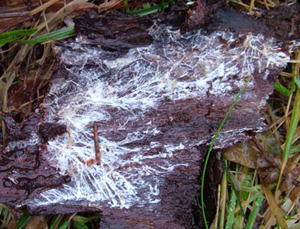
White mycelia growing on wood (photo: bugginout.com)
Once started, the rate and extent of decay depends on how long favorable conditions for fungal growth last. Decay will stop when the temperature of the wood is either too low or too high or when the moisture content is drier than the fungi's requirements. However, decay can resume when the temperature and moisture content become favorable again. Early decay sometimes is accompanied by discoloration so it may be confused with stains caused by other fungi or by chemicals. Early decay is easier to see on freshly exposed surfaces of unseasoned wood than on wood that has been exposed to and discolored by the weather.
The three major categories of wood destroying fungi are brown rot, white rot, and soft rot.
Brown Rots
Brown rots are probably the most important causes of decay of softwood species used in aboveground construction. They are sometimes called "dry rots" but this is a poor term because dry wood will not decay. Brown rot fungi break down cellulose for food, leaving a brown residue of lignin. Brown rot greatly weakens wood even before decay can be seen. The final stage of decay by brown rots is distinguished by:
- dark brown color of the wood,
- excessive shrinkage,
- cross-grain cracking,
- dry wood that can be easily crushed to a brown powder.
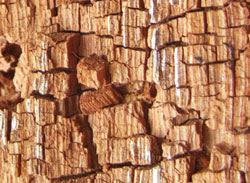
Brown rot fungus (www.basementsystems.com)
A few fungi can decay relatively dry wood because they have water-conducting strands that can carry water from damp soil to wood in lumber piles or buildings. These fungi can decay wood that otherwise would be too dry for decay to occur. They sometimes are called the "dry rot fungi", or "water-conducting fungi".
White Rots
White rots break down both lignin and cellulose leaving a bleaching effect that may make the damaged wood appear whiter than normal. Affected wood exhibits normal shrinkage and usually does not collapse or crack across the grain as with brown rot damage. Rotting wood gradually loses its strength, becoming spongy to the touch. White rot fungi usually attack hardwoods but several species also decay softwoods.
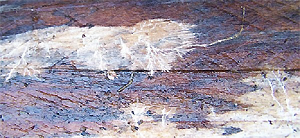
White rot fungus (photo: sawmillcreek.org)
Soft Rot
Soft rot usually attacks green (water-saturated) wood, causing a gradual shallow softening from the surface inward that resembles brown rot. The surface of affected wood darkens and this superficial layer, up to 3-4 mm deep, becomes very soft, thus the name soft rot.
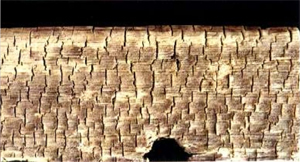
Soft rot (image: liveattack.slideshare.net)
Wood Staining Fungi
Sap-Staining Fungi
Sap-staining fungi penetrate and discolor sapwood. Unlike staining by mold fungi, sap stain cannot be removed by brushing or planing. These fungi may become established in the sapwood of standing trees, sawlogs, lumber, and timber soon after they are cut and before they have adequately dried. While strength is not appreciably affected, the wood may not be fit for use where appearance is important (such as siding, trim, furniture and exterior millwork that is to be clear-finished).
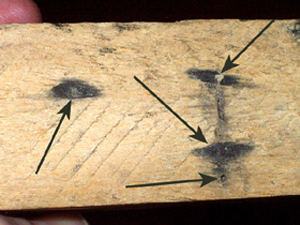
Sap stain fungus (photo: entomology.ces.ncsu.edu)
Blue stain fungi are the most common of this group. They produce bluish mycelia deep within the wood, giving a stain that may completely cover the sapwood or appear as specks, streaks, or patches in varying shades of blue.
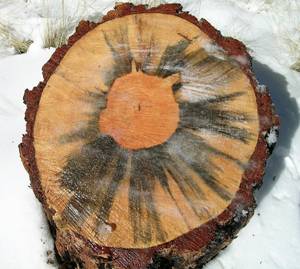
Blue stain fungus
Blue stains are not the only sap staining fungi that may infect wood. Stain color depends upon the kind of fungus and the species and moisture content of the wood. There may be yellow, orange, purple, or red stains.
Mold Fungi
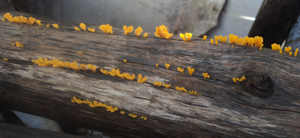
Mold fungus (photo: themoldremediation.com)
Mold fungi first appear as powdery green, yellow, brown, or black growths on the wood surface. Their colored spores usually are easy to remove. However, some surface molds may cause deep stains in open-pored hardwoods. Freshly cut or seasoned wood that is piled during warm, humid weather may be noticeably discolored with mold in 5 or 6 days. These molds do not reduce wood strength; however, they can increase the capacity of wood to absorb moisture, thus increasing the possibility of attack by decay fungi.
Chemical Stains
Chemical stains may resemble some caused by fungi. They result from chemical changes in the wood. Staining usually occurs in logs or in lumber during seasoning, and may be confused with a brown sap stain caused by fungi. The most important chemical stains are the brown stains that can downgrade lumber for some uses. They usually can be prevented by rapid air drying or using relatively low temperatures during kiln drying.
[return]
Wood-Destroying Insects
Several insect species use living trees, logs, lumber and finished wood products for food and/or shelter. These include various termites, ants, and beetles.
Termites
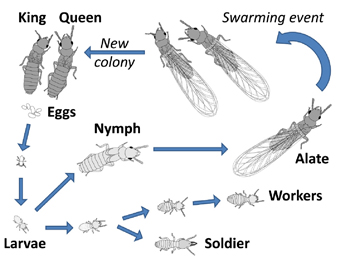
Termite life stages are: the egg, the nymph, and the adult.
Castes include winged reproductive, solders, and workers. (image: http://flrec.ifas.ufl.edu)
Eastern subterranean termites are social insects that live in underground colonies. A colony contains three castes: workers, soldiers, and winged reproductive forms (kings and queens). Each caste performs specific colony functions. The creamy-white workers cause damage as they feed on wood. They also keep the colony running. Soldiers, easily recognized by their long yellowish heads with large jaws, protect the colony from invading insects. The dark-brown or black kings and queens are the reproductive part of the colony. They leave the colony in swarms between March and June. After mating, wings break off the queens when they enter the soil to start new colonies.
Winged termites often are confused with winged ants. The easiest way to distinguish the two groups is to look at their antennae or feelers. Ants have L-shaped antennae; the antennae of termites are straight. Ants have narrow, wasp-like waists; termites have thick waists. Finally, the four equal-sized wings of a termite are almost two times longer than its body. The front wings of ants are larger than the hind wings and both are about the length of their bodies.
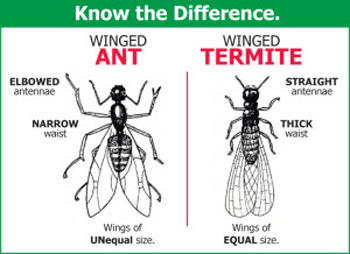
How to distinguish between ants and termites (image: primepest.net)
Jagged galleries in wood attacked by termites are coated with a mixture of soil and glue to keep the humidity high. Wood that has been infested for some time may be mostly hollow with passages and may appear rotten. Upon probing such wood with a screwdriver or similar tool, many of the hidden worker termites may spill out.
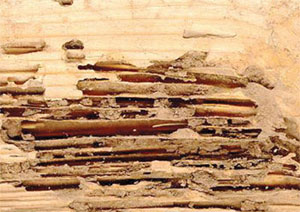
Termite galleries in wood have a jagged appearance and contain some mud
(photo: www.narragansetpestcontrol.com)
Exposed mud tubes are another sign of termites. They are a protected runway from the earth to the wood the workers are eating. In addition, the tubes may serve as swarming exits for the winged termites. Wood embedded in earth or in concrete cellar floors is especially susceptible to termites.
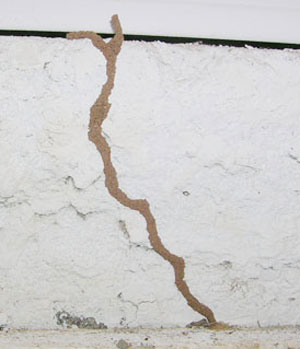
Mud tube (www.greenninjapestcontrol.com)
Breaking the connection between wood and the soil is essential in termite control. This may be done with either a chemical or a mechanical barrier.
[return]
Carpenter Ants
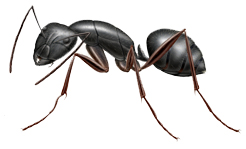
Carpenter ant
Carpenter ants vary in size (up to 1/2 inch long) and can range in color from red to black. Workers are wingless; reproductive males and females have wings. These insects commonly build nesting galleries in damp wood. Since there often will be no external signs of damage, probing the wood with a screwdriver helps reveal the excavated galleries. Another technique for locating hidden nests is to tap along wood surfaces with the blunt end of a screwdriver, listening for the hollow sound of damaged wood. If a nest is nearby, carpenter ants often will respond by making a "rustling" sound similar to the crinkling of cellophane.
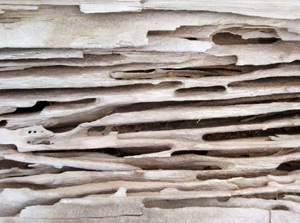
Clean carpenter ant galleries in wood (photo: mcinroybasemsntsystems.com)
Carpenter ant galleries have a smooth, sandpapered appearance and are clean; there is no mud-like material, as seen with termites. Shredded fragments of wood, like coarse sawdust, are dumped from the galleries through preexisting cracks or slits made by the ants. These accumulations are a good indication of carpenter ant activity.
[return]
Powderpost Beetles (PPB)
Powderpost beetle is a term used to describe several species of small (1/8-3/4 inches long), wood-boring insects that reduce wood to a fine, flour-like powder. The larvae chew narrow, meandering tunnels in wood as they feed. Infestations are discovered after noticing small, round "shotholes" in the wood surface and accumulations of sawdust. They are exit holes used by beetles that are leaving the wood after completing their development. Newly-emerged adults mate and lay eggs on or below the surface of bare (unfinished) wood. Tiny newly hatched larvae bore into the wood and feed from 1 to 3 years, depending on wood characteristics. You are more likely to see damage holes than the beetles because the adults are short-lived and are active mainly at night.
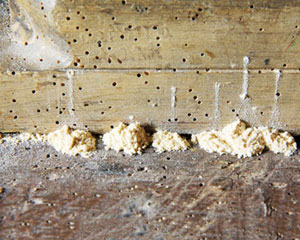
Powderpost beetle "shotholes" and sawdust (townandcountrysolutions.com)
The two most common and destructive families of powderpost beetles in Kentucky are the Lyctidae and Anobiidae.
Lyctid Powderpost Beetle
Lyctid powderpost beetles attack only hardwoods, e.g., oak, ash, walnut and hickory.
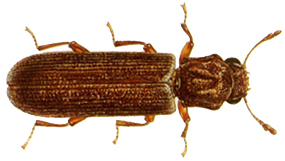
Lyctid powderpost beetle (image: publish.illinois.edu)
Lyctids rarely infest wood that is more than 5 years old so infestations generally occur in new logs and lumber. In many cases, the infestation was present when the tree was harvested or soon afterward. Typically, the infested article was constructed from untreated wood or wood that was improperly dried or stored.
Anobiid Powderpost Beetle
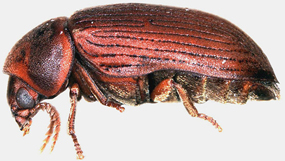
Anobiid powderpost beetle (image: itp.lucidcentral.org)
Anobiid powderpost beetles may attack both hardwoods and softwoods so infestations may be found in the same places as Lyctid beetles, as well as in structural timbers (beams, sills, joists, studs, subflooring, etc). Maple, beech, poplar and pine are especially susceptible to attack.
Anobiids prefer to infest wood that is damp; therefore, infestations usually begin in moist, poorly-ventilated areas such as crawl spaces, basements, garages and utility sheds. Under favorable moisture and temperature conditions, infestations may spread upwards into walls and upper levels of the structure and occasionally, furniture. Infestations may result from using infested lumber or from beetles flying in from outdoors. Infestations develop slowly, but wood can be reinfested year after year. This can result in extensive damage.
References
2006. G. Thomasson, J. Capizzi, F. Dost, J. Morrell, and D. Miller Wood preservation and wood products treatment training manual (http://ir.library.oregonstate.edu/xmlui/bitstream/handle/1957/20518/em8403.pdf)
Wood preservation Category 4b Study guide for commercial applicators Ohio Department of Agriculture publication for pesticide regulation 08/03 (http://www.agri.ohio.gov/Public_Docs/Pest_Study_Material/4b%20Wood%20Preservation%20Study%20Guide.pdf)
[return]
1) ____________ often (is) are the only indication that a decay fungus is present.
2) Wood stored below 35°F or above 100°F is _____________________.
- generally safe from decay
- highly vulnerable to decay
- neither, fungal infections are not affected by temperature
3) Decay fungi require a moisture content of about ___%.
4) Decay fungi thrive in water-saturated wood.
5) White thread-like growth on wood is an indication of ______________.
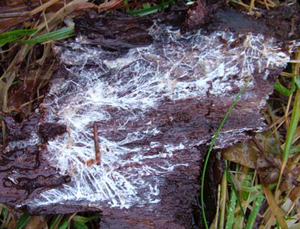
6) Once decay stops due to unfavorable temperature or moisture content of the wood, it cannot resume if the favorable conditions return.
7) Early decay is easiest to see on weathered, discolored wood.
8) Wood infected with ____________ usually has excessive shrinkage, cross-grain cracking, and can easily be crushed to a powder.
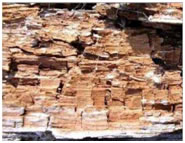
9) Wood infected with _____________ shows normal shrinkage, does not crack across the grain, and becomes spongy.
10) Sap stain can be removed from wood by brushing or planning.
11) Brown chemical stains can best be prevented by ______________________.
- using different harvesting equipment for softwoods and hardwoods
- heavy applications of wood preservatives
- rapid air drying or using relatively low temperatures during kiln drying
- harvesting susceptible tree species during the winter
12) The insect below is a ______________.
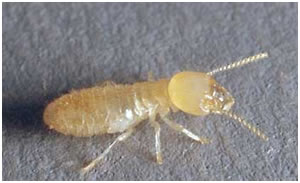
13) The damage pictured below is ______________________.
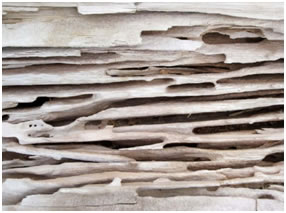
14) The damage pictured below is ______________________.
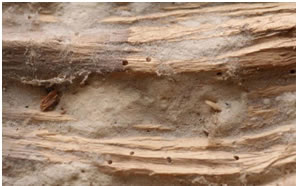
15) Termites and carpenter ants have a 4 stage life cycle consisting of egg, larva, pupa, and adult.
website content by L. Townsend website design by P. Dillon copyright © 2016 University of Kentucky Department of Entomology
University of Kentucky College of Agriculture |
S-225 Agricultural Science Center North, Lexington, KY 40546-0091 | 859.257.7450
An Equal Opportunity University |
Last modified
11/30/2018
